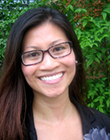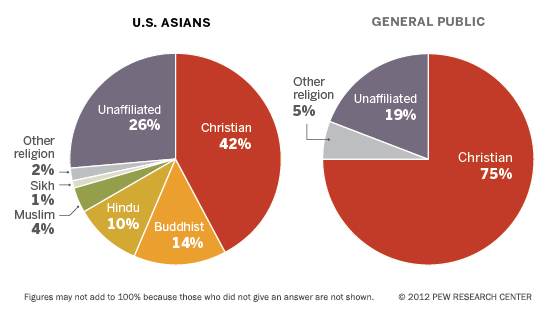Vietnamese American Religions within a Transnational Framework
The Challenges of Teaching the Vietnamese-American Experience of Transnationalism
Course SyllabusREL 249 / SOC 249 / AMST 249: Asian Religious Diasporas: The New Chosen People? |
In 1992, three years before Vietnam normalized relations with the United States, approximately fifty Vietnamese American Catholics, Caodaists, and Buddhists gathered in Rome to participate in the “Pray for Peace in Vietnam Day.” The event was organized by exiled Vietnamese members of the clergy under the auspices of the Vatican. Joining the Vietnamese Americans were Vietnamese who came from different religious backgrounds and who have made their homes in other countries, including France, Canada, and Australia. For nearly two decades, since the Fall of Saigon to communism in 1975 which led to their forced displacement, overseas Vietnamese faithful have been scattered throughout the world. Despite their geographic separation, however, they have continued to be emotionally and symbolically connected to each other. The meeting at the Vatican was a testament to their lingering bonds.
Although this was a historic event in overseas Vietnamese religious life, I have observed, from my teaching experiences at Williams College in Massachusetts and at the University of Southern California, that students often do not immediately understand the significance of these types of transnational religious activities for Vietnamese Americans and, in general, Asian Americans. Having been raised within the Internet-driven era, this generation is used to thinking of the world as a web of interconnected societies. When I showed them the Pew Research Center’s “Faith on the Move” interactive map that traces the movements of people of faith, they were genuinely intrigued, but not surprised, by it.
Transnationalism is the norm for them.
Certainly, there is some truth to the observation that cross-border ties and movements have become increasingly more common and intensified in contemporary life. The problem, however, is my observation that students assume that transnationalism must also be a common pattern among Vietnamese Americans and their religious life. When I asked students how, they would often make generalizations, invoking remittances, inter-temple support, and pilgrimages as examples of transnationalism.
In contrary to most students’ assumptions, the reality is that ties among Vietnamese faithful have been ruptured due to the traumatic history of forced displacement, kin separation, and the pressures of local assimilation. Thus, a transnational moment, such as the meeting at the Vatican, must traverse these constraining conditions. In other words, transnationalism has not been equally accessible to all in contemporary society, especially for overseas Vietnamese in the United States and other countries. This is one of the most important points that I have aimed to highlight in my teaching.
The question, then, becomes how does religious transnationalism differentiate itself from local, material, religious lives of Vietnamese Americans even after many decades of not having physical contact and/or exchanges? The meeting at the Vatican is not simply global. It reflects a particular modality of power competition and shifts that I want my students to think about and analyze. To do this, I have encouraged students to situate their observations and analyses within a transnational framework so that they can have a greater historical depth and broader contextualization of Vietnamese American religious lives.
This is quite challenging because of the disparate bodies of literature that must be bridged in order to first, construct a transnational perspective and second, analyze transnational religious practices among Vietnamese Americans. The research on Vietnamese American religions within cross-border contexts itself has been quite limited. For example, Janet Hoskins (2013), Karen Fjeldstad (2006), Peter Phan (2003), and I (2014) are the only scholars who have specialized on this topic. The good news is that there are a larger number of studies on Vietnamese American religious practices in the United States. They are usually theoretically grounded in debates about immigration and adaptation, such as those by Carl Bankston and Min Zhou (2000). There is an even larger body of research on nonreligious aspects of Vietnamese American lives, from mental health to literature. When I teach, I endeavor to make the classroom an important space for my students to link these varying literatures and construct a critical transnational lens toward Vietnamese American religions.
An Inductive Approach
Paradoxically, building this bridge toward macro-level analysis requires beginning with introducing students to the personal lives of Vietnamese Americans. The study of Vietnamese Americans and their religious lives are often unfamiliar to most students, including those who may self-identify as Vietnamese Americans. At Williams College, my classes were the first Asian American courses that any of my students had taken!
First and foremost, therefore, I have strived to engage students at their level. To connect them to the subject of study, I have often integrated primary sources and activities such as memoirs, guest speakers, and site visits (including virtual site visits). When appropriate, I have also opened up and shared my personal life as a Vietnamese refugee raised within a Catholic household. Regardless of their academic majors, nearly all of my students respond positively to my personal narratives. As Yoo (1999) has argued, “narrative matters” in the study of religions among Asian Americans because it enables us to “discover who we are and define our relationship to the world around us” (10). Similarly, Jane Iwamura (1996) has contended that this “retrieval” process of bringing the Asian American subjects to the front is necessary “to foster scholarship and understanding of Asian spiritual and philosophical traditions from an Asian American point of view” (165).
From this introduction to the lives of Vietnamese Americans, I would next encourage students to ask questions that situate religious practices and beliefs within a transnational framework. These include general questions that locate the experiences of Vietnamese Americans in parallel with other immigrants. For example: If Vietnamese Americans, similar to many other immigrants, have already made their new homes in the United States, why do they want to maintain transnational religious ties to Vietnamese in other countries? How do they initiate, institutionalize, and sustain these relationships? As for specific questions particular to the experiences of Vietnamese Americans, they may include: How does trauma manifest itself in daily Vietnamese American religious life at the local and global levels? How do Vietnamese Americans sanctify their dead homeland, the former Republic of South Vietnam, through collective religious practices with Vietnamese in other countries? I encourage my students to answer these questions by reflecting on the primary materials and relate them to theoretical pieces about transnationalism, diaspora, and religion.
I have found that this inductive approach, from personal experiences to macro-level analysis, is especially effective when teaching about theories and concepts around emotionally and politically charged subjects such as race, ethnicity, religion, and immigration in Vietnamese American lives. Students feel less threatened or targeted because they can evaluate the concept through a story that is real and personal. From this concrete connection to larger trends and patterns, I then guide students to create the next bridge toward theorization. I encourage them to raise questions about particular conceptions and misconceptions and challenge them to defend their opinions and to articulate their perspectives.
I emphasize that class assignments and assessments are not meant to test students’ knowledge, but are opportunities for them to contribute to the new and burgeoning fields of Vietnamese Americans and transnational religions. I believe that this has encouraged and motivated many of them to take risks and to pursue creative ideas. Last year, I had a student who decided to write his final paper on the impacts of generational differences among Vietnamese American Caodaists on their transnational network. He could have selected an easier and more accessible religious group. Instead, he wanted to challenge himself by learning about a religious community that is unfamiliar to him. Students also worked with me to produce two ethnographic films on Vietnamese Catholicism in the United States and Vietnam. The films can be found on sites.williams.edu/ttn1/films. It gives me great joy to see these works my students have created, and to know that my teaching has inspired further contributions to the fields of Vietnamese American transnational religions.
 Thien-Huong T. Ninh, PhD, is a Gaius Charles Bolin Fellow at Williams College. In May 2013, she successfully defended her dissertation, “Religion of a Different Color: Vietnamese Catholic and Caodai US-Cambodia Ties,” at the University of Southern California. Her research interests include diaspora, race, ethnicity, comparative religion, and international migration and transnationalism. Her dissertation investigates two Vietnamese transnational religious communities—Catholic and Caodai—based in the United States and Cambodia. The project contributes to discussions about immigrant integration, ethno-religious diasporic formation, and transnational religious ties. For more information about her publications, research, and ethnographic films, please visit http://sites.williams.edu/ttn1/.
Thien-Huong T. Ninh, PhD, is a Gaius Charles Bolin Fellow at Williams College. In May 2013, she successfully defended her dissertation, “Religion of a Different Color: Vietnamese Catholic and Caodai US-Cambodia Ties,” at the University of Southern California. Her research interests include diaspora, race, ethnicity, comparative religion, and international migration and transnationalism. Her dissertation investigates two Vietnamese transnational religious communities—Catholic and Caodai—based in the United States and Cambodia. The project contributes to discussions about immigrant integration, ethno-religious diasporic formation, and transnational religious ties. For more information about her publications, research, and ethnographic films, please visit http://sites.williams.edu/ttn1/.

